Rosa Parks
rosa park作文
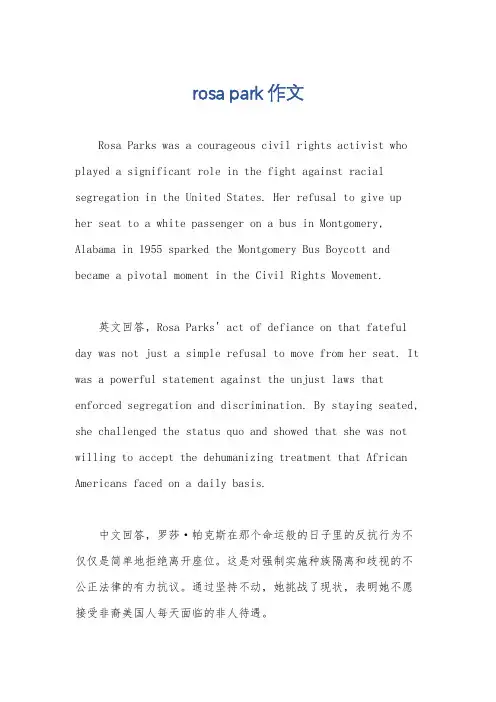
rosa park作文Rosa Parks was a courageous civil rights activist who played a significant role in the fight against racial segregation in the United States. Her refusal to give up her seat to a white passenger on a bus in Montgomery, Alabama in 1955 sparked the Montgomery Bus Boycott and became a pivotal moment in the Civil Rights Movement.英文回答,Rosa Parks' act of defiance on that fateful day was not just a simple refusal to move from her seat. It was a powerful statement against the unjust laws that enforced segregation and discrimination. By staying seated, she challenged the status quo and showed that she was not willing to accept the dehumanizing treatment that African Americans faced on a daily basis.中文回答,罗莎·帕克斯在那个命运般的日子里的反抗行为不仅仅是简单地拒绝离开座位。
这是对强制实施种族隔离和歧视的不公正法律的有力抗议。
通过坚持不动,她挑战了现状,表明她不愿接受非裔美国人每天面临的非人待遇。
著名女性成就英语作文
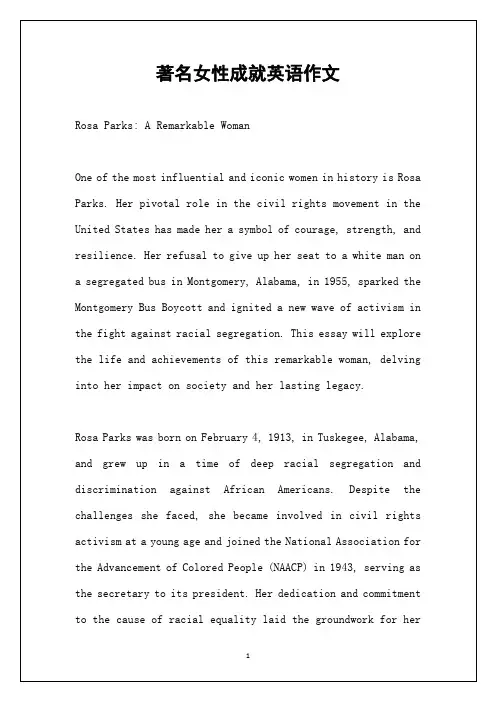
Rosa Parks: A Remarkable Woman
One of the most influential and iconic women in history is Rosa Parks. Her pivotal role in the civil rights movement in the United States has made her a symbol of courage, strength, and resilience. Her refusal to give up her seat to a white man on a segregated bus in Montgomery, Alabama, in 1955, sparked the Montgomery Bus Boycott and ignited a new wave of activism in the fight against racial segregation. This essay will explore the life and achievements of this remarkable woman, delving into her impact on society and her lasting legacy.
Rosa Parks passed away on October 24, 2005, but her legacy lives on. Her impact on the civil rights movement and her unwavering commitment to equality have left an enduring imprint on the history of the United States and the world. Her courage in the face of adversity and her belief in the power of ordinary people to effect extraordinary change serves as a timeless reminder of the potential for individuals to make a difference in the world. As we reflect on the life of Rosa Parks, we are reminded of the power of one person to inspire meaningful, transformative, and lasting change.
Rosa Parks

69题
• How was Rosa Parks treated after her death?
• A. She was named “mother of the civil rights movement. ” • B. She was received by President Bush at the Capitol. • C. She was given the Presidential Medal of Freedom. • D. She was honored to lie in state at the Capitol.
Rosa Parks
Rosa Parks ,1913年2月4日出生在亚拉巴马州的 一个黑人家庭。1955年12月1日,她因在公共汽车上 拒绝给一位白人男子让座,拉开了美国现代民权运 动(civil rights movements)的序幕。 当时,亚拉巴 马州实行吉姆· 克劳法,这是一部对黑人进行隔离、 压制的种族歧视性法律。它规定黑人在乘公交车、 到餐厅以及其他公共设施时不能与白人坐在一起。 由于当时车上的人很多,司机要求罗莎· 帕克斯将座 位让给一位白人男子,但她拒绝了。此后,这个看 似不起眼的“叛逆行为”发展成改变美国历史进程 的民权运动。罗莎· 帕克斯自己回忆说:“那天像平 常日子一样,唯一使它变得重要的是全体黑人的团 结。”底特律市市长基尔帕特里克评价说:“她通 过坐下去而站了起来。”
70题
The black woman, however, turned the course of American history in December 1955 when he refused to give up her seat to a white man. 这个黑人妇女,在1955年拒绝给一个白人让 座,改变了美国历史的进程。
英文睡前故事 ROSA PARKS
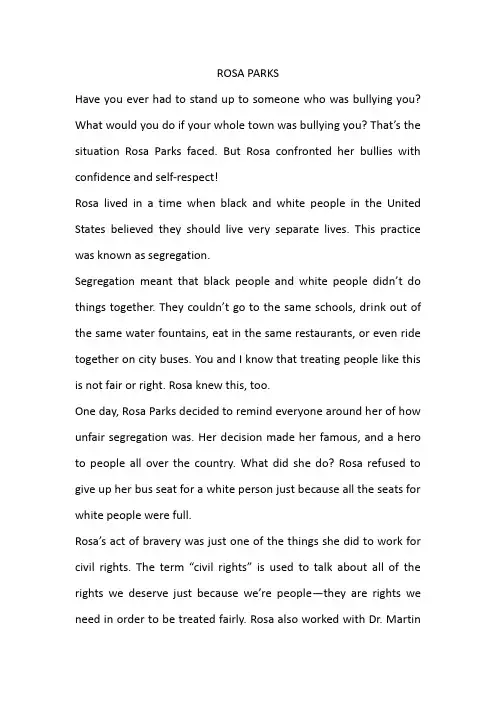
ROSA PARKSHave you ever had to stand up to someone who was bullying you? What would you do if your whole town was bullying you? That’s the situation Rosa Parks faced. But Rosa confronted her bullies with confidence and self-respect!Rosa lived in a time when black and white people in the United States believed they should live very separate lives. This practice was known as segregation.Segregation meant that black people and white people didn’t do things together. They couldn’t go to the same schools, dri nk out of the same water fountains, eat in the same restaurants, or even ride together on city buses. You and I know that treating people like this is not fair or right. Rosa knew this, too.One day, Rosa Parks decided to remind everyone around her of how unfair segregation was. Her decision made her famous, and a hero to people all over the country. What did she do? Rosa refused to give up her bus seat for a white person just because all the seats for white people were full.Rosa’s act of bravery was just one of the things she did to work for civil rights. The term “civil rights” is used to talk about all of the rights we deserve just because we’re people—they are rights we need in order to be treated fairly. Rosa also worked with Dr. MartinLuther King, Jr. for civil rights, earning her the nickname “the First Lady of Civil Rights.”It’s not easy to stand up for something you know is right when so many other people are against you. Rosa did it, though, and so can you. Rosa Parks’ self-respect inspired many others to stand up against segregation.Why is self-respect so important? When you have self-respect, you love yourself for who you are. You don’t just love yourself because you look good or you do something well. When you have self-respect, you know you’r e valuable. You love yourself just because you are you.Did you know that bus seats were left empty to honor Rosa on the 50th anniversary of her arrest?。
Rosa Park课文答案
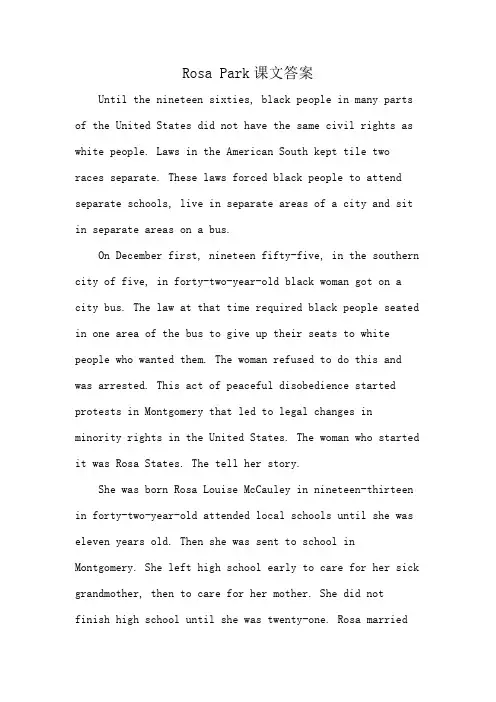
Rosa Park课文答案Until the nineteen sixties, black people in many parts of the United States did not have the same civil rights as white people. Laws in the American South kept tile two races separate. These laws forced black people to attend separate schools, live in separate areas of a city and sit in separate areas on a bus.On December first, nineteen fifty-five, in the southern city of five, in forty-two-year-old black woman got on a city bus. The law at that time required black people seated in one area of the bus to give up their seats to white people who wanted them. The woman refused to do this and was arrested. This act of peaceful disobedience started protests in Montgomery that led to legal changes inminority rights in the United States. The woman who started it was Rosa States. The tell her story.She was born Rosa Louise McCauley in nineteen-thirteen in forty-two-year-old attended local schools until she was eleven years old. Then she was sent to school in Montgomery. She left high school early to care for her sick grandmother, then to care for her mother. She did notfinish high school until she was twenty-one. Rosa marriedRaymond Parks in nineteen thirty-two.He was a barber who cut men's hair. He was also a civil rights hair. He worked for the local group of the National Association for the Advancement of Colored People. In nineteen forty-three, Missus Parks became an officer in the group and later its youth leader.Rosa Parks was a seamstress in Montgomery. She worked sewing clothes from the nineteen thirties until nineteen fifty-five. Then she became a representation of freedom for millions of African-Americans. In much of the American South in the nineteen riffles, the first rows of seats on city buses were for white people only. Black people sat in the back of the bus. Both groups could sit in a middle bus. Both people sitting in that part of the bus were expected to leave their seats if a white person wanted to sit there. Rosa Parks and three other black people were seated in the middle area of the bus when a white person got on the bus and wanted a seat.The bus driver demanded that all four black people leave their seats so the white person would not have to sit next to any of them. The three other blacks got up, but Missus Parks refused. She was arrested. Some popularstories about that incident include the statement that Rosa Parks refused to leave her seat because her feet were tired. But she herself said in later years that this was false. What she was tired of, she said, was accepting unequal treatment. She explained later that this seemed to be the place for her to stop being pushed around and tofind out what human rights she had, if any.。
parks三步法原理
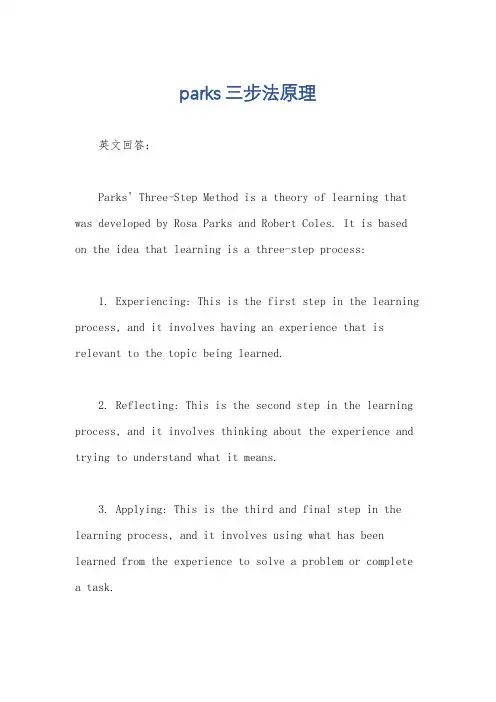
parks三步法原理英文回答:Parks' Three-Step Method is a theory of learning that was developed by Rosa Parks and Robert Coles. It is based on the idea that learning is a three-step process:1. Experiencing: This is the first step in the learning process, and it involves having an experience that is relevant to the topic being learned.2. Reflecting: This is the second step in the learning process, and it involves thinking about the experience and trying to understand what it means.3. Applying: This is the third and final step in the learning process, and it involves using what has been learned from the experience to solve a problem or complete a task.Parks' Three-Step Method is a powerful tool for learning because it allows learners to actively engage with the material and to make meaningful connections between their experiences and their learning.中文回答:帕克斯三步法是罗莎·帕克斯和罗伯特·科尔斯提出的学习理论。
罗莎帕克斯故事美国民权运动的奋斗者与倡导者
罗莎帕克斯故事美国民权运动的奋斗者与倡导者罗莎帕克斯故事:美国民权运动的奋斗者与倡导者罗莎·帕克斯(Rosa Parks)是美国历史上最著名的民权运动倡导者之一。
她以勇气和毅力,为公民权利和种族平等的斗争做出了重要的贡献。
在这篇文章中,我们将探索罗莎·帕克斯的故事,了解她在美国民权运动中的角色和贡献。
第一节:早年生活罗莎·帕克斯于1913年2月4日出生在美国阿拉巴马州的图斯基吉(Tuskegee)。
作为一个非洲裔美国人,她在种族隔离主义触手可及的南方地区度过了她的童年和青年时期。
在这个时期,种族主义在南方社会中始终占据主导地位。
第二节:巴士抗议事件1955年12月1日,罗莎·帕克斯在蒙哥马利市的一辆巴士上发生了一个事件,这件事成为了她的奋斗之旅的起点。
在那天晚上,帕克斯被告知要让座位给一个白人乘客,但她拒绝屈服,这引起了轰动。
她的拒绝引发了一系列抗议活动和蒙哥马利巴士抵制运动,这成为了美国民权运动的重要里程碑。
第三节:蒙哥马利巴士抵制运动在罗莎·帕克斯的巴士抗议事件之后,蒙哥马利市的非裔美国人社区开始了长达一年的巴士抵制运动。
这个运动的目标是废除巴士种族隔离政策,并确保所有乘客都受到平等对待。
梅廷·盖恩斯(Martin Luther King Jr.)成为了抵制运动的领导人,并通过非暴力抗议手段来推动变革。
第四节:最高法院胜利1956年,联邦最高法院裁定阿拉巴马州的巴士种族隔离政策违宪,这是蒙哥马利巴士抵制运动的重要胜利。
这一裁决促使阿拉巴马州终止了巴士种族隔离政策,并在全国范围内引发了更大规模的变革。
第五节:罗莎·帕克斯的影响罗莎·帕克斯通过她的勇气和毅力,成为了美国民权运动的标志性人物。
她的行动鼓舞了无数其他人参与到民权斗争中。
她的故事在全球范围内传播,成为反对种族主义和不平等的象征。
结论罗莎·帕克斯是一位值得尊敬的奋斗者和倡导者,她为美国民权运动做出了巨大的贡献。
2016年全国1卷高考英语试题解析
2016高考全国Ⅰ卷英语第一部分阅读理解(共两节,满分40分)AYou probably know who Marie Curie was,but you may not have heard of Rachel Carson.Of the outstanding ladies listed below,who do you think was the most important woman of the past100 years?Jane Addams(1860-1935)Anyone who has ever been helped by a social worker has Jane Addams to thank.Addans helped the poor and worked for peace.She encouraged a sense of community(社区)by creating shelters and promoting education and services for people in need In1931,Addams became the first American woman to win the Nobel Peace Prize.Rachel Carson(1907-1964)If it weren’t for Rachel Carson,the environmental movement might not exist today.Her popular 1962book Silent Spring raised awareness of the dangers of pollution and the harmful effects of chemicals on humans and on the world’s lakes and oceans.Sandra Day O’Connor(1930-present)When Sandra Day O’Connor finished third in her class at Stanford Law School,in1952,she could not find work at a law firm because she was a woman.She became an Arizona state senator(参议员)and,in1981,the first woman to join the U.S.Supreme Court.O’Connor gave the deciding vote in many important cases during her24years on the top court.Rosa Parks(1913-2005)On December1,1955,in Montgomery,Alabama,Rasa Parks would not give up her seat on a bus to1。
Rosa park
Until the nineteen sixties, black people in many parts of the United States did not have the same civil rights as white people. Laws in the American South kept tile two races separate. These laws forced black people to attend separate schools, live in separate areas of a city and sit in separate areas on a bus.On December first, nineteen fifty-five, in the southern city of Montgomery, Alabama, a forty-two year old black woman got on a city bus. The law at that time required black people seated in one area of the bus to give up their seats to white people who wanted them. The woman refused to do this and was arrested. This act of peaceful disobedience started protests in Montgomery that led to legal changes in minority rights in the United States. The woman who started it was Rosa Parks. Today, we tell her story.She was born Rosa Louise McCauley in nineteen-thirteen in Tuskegee, Alabama. She attended local schools until she was eleven years old. Then she was sent to school in Montgomery. She left high school early to care for her sick grandmother, then to care for her mother. She did not finish high school until she was twenty-one. Rosa married Raymond Parks in nineteen thirty-two. He was a barber who cut men's hair. He was also a civil rights activist. Together, they worked for the local group of the National Association for the Advancement of Colored People. In nineteenforty-three, Missus Parks became an officer in the group and later its youth leader.Rosa Parks was a seamstress in Montgomery. She worked sewing clothes from the nineteen thirties until nineteen fifty-five. Then she became a representation of freedom for millions of African-Americans. In much of the American South in the nineteen riffles, the first rows of seats on city buses were for white people only. Black people sat in the back of the bus. Both groups could sit in a middle area. However, black people sitting in that part of the bus were expected to leave their seats if a white person wanted to sit there. Rosa Parks and three other black people were seated in the middle area of the bus when a white person got on the bus and wanted a seat. The bus driver demanded that all four black people leave their seats so the white person would not have to sit next to any of them. The three other blacks got up, but Missus Parks refused. She was arrested. Some popular stories about that incident include the statement that Rosa Parks refused to leave her seat because her feet were tired. But she herself said in later years that this was false. What she was really tired of, she said, was accepting unequal treatment. She explained later that this seemed to be the place for her to stop being pushed around and to find out what human rights she had, if any.A group of black activist women in Montgomery was known as the Women's Political Council. The group was working to oppose the mistreatment of black bus passengers. Blacks had been arrested and even killed for violating orders from bus drivers. Rosa Parks was not the first black person to refuse to give up a seat on the bus for a white person. But black groups in Montgomery considered her to be the right citizen around whom to build a protest because she was one of the finest citizens of the city.The women's group immediately called for all blacks in the city to refuse to ride on city buses on the day of Missus Parks' trial, Monday, December fifth. The result was that forty thousand people walked and used other transportation on that day. That night, at meetings throughout the city, blacks in Montgomery agreed to continue to boycott the city buses until their mistreatment stopped. They also demanded that the city hire black bus drivers and that anyone be permitted to sit in the middle of the bus and not have to get up for anyone else. The Montgomery bus boycott continued for three hundred eighty-one days.It made racial separation illegal on city buses. That decision came on November thirteenth, nineteen fifty-six, almost a year after Missus Parks’’ arrest. The boycott in Montgomery ended the day after the court order arrived, December twentieth.Rosa Parks and Martin Luther King, Junior had started a movement of non-violent protest in the South. That movement changed civil rights in the United States forever. Martin Luther King became its famous spokesman, but he did not live to see many of the results of his work. Rosa Parks did.Life became increasingly difficult for Rosa Parks and her family after the bus boycott. She was dismissed from her job and could not find another. So the Parks family left Montgomery. They moved first to Virginia, then to Detroit, Michigan. Missus Parks worked as a seamstress until nineteen sixty-five. Then, Michigan Representative John Conyers gave her a job working in his congressional office in Detroit. She retired from that job in nineteen eighty-eight.Through the years, Rosa Parks continued to work for the NAACP and appeared at civil rights events. She was a quiet woman and often seemed uneasy with her fame. But she said that she wanted to help people, especially young people, to make useful lives for themselves and to help others. In nineteen eighty-seven, she founded the Rosa and Raymond Parks Institute for Self-Development to improve the lives of black children.Rosa Parks received two of the nation’’s highest honors for her civi l rights activism. In nineteen ninety-six, President Clinton honored her with the Presidential Medal of Freedom. And in nineteen ninety-nine, she received the Congressional Gold Medal of Honor. In her later years, Rosa Parks was often asked how much relations between the races had improved since the civil rights laws were passed in the nineteen sixties. She thought there was still a long way to go. Yet she remained the face of the movement for racial equality in the United States.Rosa Parks died on October twenty-fourth, two thousand five. She was ninety-two years old. Her body lay in honor in the United States Capitol building in Washington. She was the first American woman to be so honored. Thirty thousand people walked silently past her body to show theirrespect.Representative Conyers spoke about what this woman of quiet strength meant to the nation. He said: "There are very few people who can say their actions and conduct changed the face of the nation. Rosa Parks is one of those individuals."Rosa Parks meant a lot to many Americans. Four thousand people attended her funeral in Detroit, Michigan. Among them were former President Bill Clinton, his wife Senator Hillary Rodham Clinton, the Reverend Jesse Jackson, and Nation of Islam leader Louis Farrakhan. President Clinton spoke about remembering the separation of the races on buses in the South when he was a boy. He said that Rosa Parks helped to set all Americans free. He said the world knows of her because of a single act of bravery that struck a deadly blow to racial hatred. Earlier, the religious official of the United States Senate spoke about her at a memorial service in Washington. He said Rosa Parks’’ s bravery serves as an example of the power of small acts. And the Reverend Jesse Jackson commented in a statement about what her small act of bravery meant for African-American people. He said that on that bus in nineteen fifty-five, "She sat down in order that we might stand up and she opened the doors on the long journey to freedom."Rosa Parks is a pioneer in the fight for legal changes in minority rights.。
美国黑人民权活动家罗莎帕克斯
美国黑人民权活动家罗莎帕克斯罗莎帕克斯(Rosa Parks)是20世纪最著名的美国黑人民权活动家之一。
她以坚定的意志和勇气在美国的民权运动中发挥了重要作用。
本文将重点介绍罗莎帕克斯的生平和她对黑人民权事业的贡献。
一、生平背景罗莎帕克斯于1913年2月4日出生在美国阿拉巴马州的一个贫困家庭中。
在她的成长过程中,她亲身经历了美国南方种族隔离政策的残酷现实。
这种制度导致黑人受到严重的歧视和不公平待遇。
然而,罗莎从小就对不平等感到愤怒,并决心为黑人争取平等权益。
二、著名事件1955年,罗莎帕克斯成为了美国民权运动的象征人物。
当时,她在蒙哥马利市乘坐公交车时,拒绝让座给一个白人乘客。
根据当时的种族隔离法规定,黑人必须让座给白人。
然而,罗莎坚守自己的座位,并拒绝屈服于不公正的待遇。
这一行为引发了轰动效应,成为推动美国民权运动兴起的重要契机。
三、抵制运动罗莎帕克斯的勇敢行为引发了蒙哥马利市黑人社区的强烈反应。
当地著名民权领袖马丁·路德·金恩(Martin Luther King Jr.)等人带领抵制运动,呼吁黑人抵制公共交通系统。
这场抵制运动持续了一年之久,最终导致了美国最高法院裁定种族隔离政策违宪。
这一事件被视为美国民权运动的重要转折点。
四、对民权运动的影响罗莎帕克斯的勇敢举动产生了深远的影响。
她展示了黑人社区的力量和团结,鼓舞了无数人为平等权益而奋斗。
她的行为也引发了更广泛的种族平等运动,推动了美国社会的变革。
罗莎帕克斯被誉为民权运动的先驱之一,她对于美国历史的贡献不可忽视。
五、后期生活尽管罗莎帕克斯在民权运动中扮演了重要角色,但她后来并没有停止她的追求平等的活动。
她继续参与社会公正的事业,并亲自创办了罗莎帕克斯基金会,为促进平等和公正而努力。
六、遗产2013年,罗莎帕克斯去世,享年92岁。
她的勇气和奉献精神将永远激励着后代。
她的故事被载入美国历史,并成为全世界追求平等和正义的榜样。
- 1、下载文档前请自行甄别文档内容的完整性,平台不提供额外的编辑、内容补充、找答案等附加服务。
- 2、"仅部分预览"的文档,不可在线预览部分如存在完整性等问题,可反馈申请退款(可完整预览的文档不适用该条件!)。
- 3、如文档侵犯您的权益,请联系客服反馈,我们会尽快为您处理(人工客服工作时间:9:00-18:30)。
In one’s opinion
辞海拾珍
have a good/high 10. 对。。。评价好/坏 low/poor opinion of 11. 抓住机会做某事 take the opportunity to do.
12. 反对 be opposed to 13.与。。。相反 be opposite to 14. 乐观的,积极地 optimistic 15. 可选择的 optional 16. 否则 or else 17. 更确切地说 or rather
辞海拾珍
1. 到。。。上面 onto 2. 有意接受,对。。。 be open to 开放 In the open air 3. 在露天 4. n. 开放,开始,开 opening 端 5. 歌剧 opera 6. 给某人动手术 operate 7. 手术;操作;运转 operation 8. 操作人员;接线员 operator 9. 依照某人的看法
Condoleezza Rice
Former Secretary of State of the USA
• In American history Parks is the first woman to lie in state at the Capitol, a very high regard (尊重)usually reserved(保留,预订) for Presidents of the United States.
70题
The black woman, however, turned the course of American history in December 1955 when he rto a white man. 这个黑人妇女,在1955年拒绝给一个白人让 座,改变了美国历史的进程。
Rosa Parks
Rosa Parks ,1913年2月4日出生在亚拉巴马州的 一个黑人家庭。1955年12月1日,她因在公共汽车上 拒绝给一位白人男子让座,拉开了美国现代民权运 动(civil rights movements)的序幕。 当时,亚拉巴 马州实行吉姆· 克劳法,这是一部对黑人进行隔离、 压制的种族歧视性法律。它规定黑人在乘公交车、 到餐厅以及其他公共设施时不能与白人坐在一起。 由于当时车上的人很多,司机要求罗莎· 帕克斯将座 位让给一位白人男子,但她拒绝了。此后,这个看 似不起眼的“叛逆行为”发展成改变美国历史进程 的民权运动。罗莎· 帕克斯自己回忆说:“那天像平 常日子一样,唯一使它变得重要的是全体黑人的团 结。”底特律市市长基尔帕特里克评价说:“她通 过坐下去而站了起来。”
Rosa Parks action made American history.
68. The political impact(影响) of Rosa Parks lies in the fact that she . • A. helped Condoleezza Rice achieve political success (上届美国国务卿赖斯) • B. joined the civil rights movement at a young age • C. made racial equality(种族平等) a common value(共同的价值观) in American society • D. set a good example in her early life for other black Americans
69题
• How was Rosa Parks treated after her death?
• A. She was named “mother of the civil rights movement. ” • B. She was received by President Bush at the Capitol. • C. She was given the Presidential Medal of Freedom. • D. She was honored to lie in state at the Capitol.
